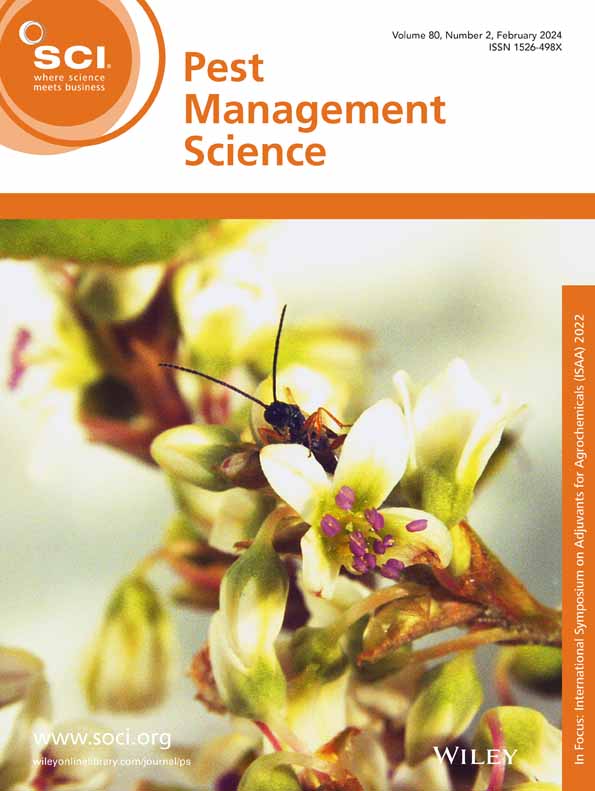内生青霉菌brefeldium F4a的吲哚二萜及其对果夜蛾的拒食和杀虫活性
IF 3.8
1区 农林科学
Q1 AGRONOMY
引用次数: 0
摘要
背景夜蛾(鳞翅目:夜蛾科)是世界上主要的农业害虫之一,对作物造成重大危害和严重的经济损失。由于frugiperda已产生广泛的耐药性,迫切需要环保型杀虫剂。因此,寻找天然的拒食或杀虫先导化合物已成为当务之急。结果从内生青霉菌brefeldium F4a中分离得到3个新的吲哚二萜类化合物,分别为paspasamine A(1)、paspasamine B(2)和paspalitrem D(3),以及9个已知化合物(化合物4 ~ 12)。通过全面的光谱数据分析[一维(1D)和二维(2D)核磁共振(NMR),高分辨率电喷雾电离质谱(HR - ESI - MS),紫外线(UV),红外(IR)]和电子圆二色性(ECD)计算确定了它们的结构。进一步推导了这些化合物的生物合成途径。生物试验结果表明,化合物8对frugiperda幼虫的拒食活性优于印楝素,化合物5 ~ 7对frugiperda幼虫的杀虫活性优于阿维菌素。此外,比较转录组分析显示化合物6具有明显的杀虫机制。在早期阶段,它调节肽酶和几丁质酶相关基因的表达。随后,这种调控影响角质层蛋白相关基因及其他相关基因的表达,最终导致S. frugiperda幼虫死亡。实时定量聚合酶链反应(RT - qPCR)实验进一步证实了这些结果。结论本研究将为开发吲哚二萜作为新型微生物杀虫剂,用于防治果蚜提供有价值的信息。©2025化学工业协会。本文章由计算机程序翻译,如有差异,请以英文原文为准。

Indole‐diterpenoids from an endophytic Penicillium brefeldianum F4a and their antifeedant and insecticidal activities against Spodoptera frugiperda
BACKGROUNDSpodoptera frugiperda (Lepidoptera: Noctuidae) is one of the world's major agriculture pests, causing significant crop damage and serious economic losses. As S. frugiperda has developed widespread resistance, environmentally friendly insecticides are urgently needed. Therefore, searching for natural antifeedant or insecticidal lead compounds has become imperative.RESULTSThree new indole diterpenoids, paspamine A (1), paspamine B (2), and paspalitrem D (3), along with nine known ones (compounds 4–12), were isolated from an endophytic Penicillium brefeldianum F4a. Their structures were identified through comprehensive spectroscopic data analysis [one‐dimensional (1D) and two‐dimensional (2D) nuclear magnetic resonance (NMR), high‐resolution electrospray ionization mass spectrometry (HR‐ESI‐MS), ultraviolet (UV), infrared (IR)], and electronic circular dichroism (ECD) calculations. Furthermore, plausible biosynthetic pathways of these compounds were deduced. The bioassay results indicated that compound 8 displayed more significant antifeedant activity against S. frugiperda larvae than azadirachtin and compounds 5–7 demonstrated superior insecticidal activities compared to abamectin. Moreover, comparative transcriptome analysis revealed that compound 6 exerted a distinct insecticidal mechanism. In the early stages, it regulated the expression of genes associated with peptidases and chitinases. Subsequently, this regulation influenced the expression of genes related to cuticle proteins and other relevant genes, ultimately resulting in S . frugiperda larval death. These results were further confirmed by real‐time quantitative polymerase chain reaction (RT‐qPCR) experiments.CONCLUSIONThis research will provide valuable information for the development of indole diterpenoids as novel microbial insecticides for the management of S. frugiperda . © 2025 Society of Chemical Industry.
求助全文
通过发布文献求助,成功后即可免费获取论文全文。
去求助
来源期刊

Pest Management Science
农林科学-昆虫学
CiteScore
7.90
自引率
9.80%
发文量
553
审稿时长
4.8 months
期刊介绍:
Pest Management Science is the international journal of research and development in crop protection and pest control. Since its launch in 1970, the journal has become the premier forum for papers on the discovery, application, and impact on the environment of products and strategies designed for pest management.
Published for SCI by John Wiley & Sons Ltd.
 求助内容:
求助内容: 应助结果提醒方式:
应助结果提醒方式:


